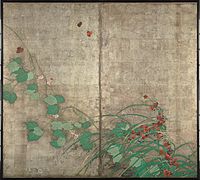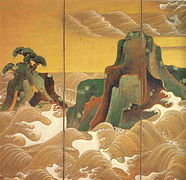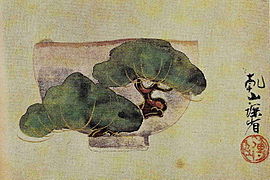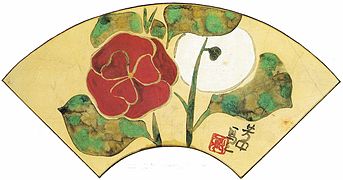Rimpa
Rimpa ( Japanese 琳 派 ), also Kōrin-ha ( 光 琳 派 ) or Sōtatsu-Kōrin-ha ( 宗 達 光 琳 派 ), is a school of Japanese painting , named after its important representative Ogata Kōrin or Tawaraya Sōtatsu , which from the end of the The 16th century flourished into the 19th century without a direct teacher-student relationship in any case.
Stylistically, it is characterized by the use of bright colors, including gold and silver paint.
The beginning
Today, the Rimpa school not only includes the namesake Kōrin and his younger brother Kenzan, but also
- Tawaraya Sōtatsu ( 俵 屋 宗 達 ; active from 1600 to the 1640s). Sōtatsu, who began as a manufacturer of painted fans, developed from a craftsman to an artist, adopting decorative elements from the Tosa and Kanō schools without following their academic rigor in the design of the images.
Kōrin and Kenzan
Two generations later followed
- Ogata Kōrin ( 尾形 光 琳 ; 1658–1716). Sōtatsu was so impressed by Sōtatsu that he painted his large pair of screens, "Matsushima", in a similar form and copied the smaller pair, "God of Wind and Thunder", fairly accurately.
- Ogata Kenzan ( 尾形 乾 山 ; 1663–1743). Kōrin's younger brother was mainly active as a potter, with Kōrin occasionally painting his square ceramic bowls.
Kōrin's generation
Kōrin's painting style followed, if not as a direct student, u. a.
- Watanabe Shikō ( 渡 辺 始興 ; 1681–1756). Shikō, who came from Kyoto, first painted in the Kanō style, but then oriented himself to Ogata Kōrin. A well-known work is the pair of adjustable screens “The Mountains of Yoshino ”, which reproduces the famous cherry blossoms there.
- Fukae Roshū ( 深 江 蘆 舟 , today simplified 芦 舟 ; 1699–1757) came from Kyoto. He may have known Kōrin, whose style he partly followed, but in his picture "On the Ivy Path" ( Tokyo National Museum ) it is more based on Sōtatsu.
- Nakamura Hōchū ( 中 村 芳 中 ;? –1819), also from Kyoto, lived later than the aforementioned and was mainly active in Osaka. In 1802 he published a printed picture book on Kōrin, Kōrin gafu .
The big conclusion
After a break of a generation, u. a.
- Sakai Hōitsu ( 酒井 抱 一 ; 1761-1828) Hōitsu (actual name: Tadanao) was a younger brother of the daimyō of Himeji , Sakai Tadazane . At the age of 37 he took over the function of higher priest in the Nishi Hongan-ji for a short time , but then lived and worked in Edo. The aristocratic origin is palpable in his works. His pair of screens, “Summer and Autumn Flowers” in the Tokyo National Museum is painted on a silver background. On the back there are Ogata Kōrin's "Wind and Thunder God" copy.
- Suzuki Kiitsu ( 鈴木 其一 ; 1796-1858) was the most gifted student of Hōitsu. He comes from a family of dyers in Ōmi province , and was then adopted by Suzuki Reitan, a samurai from the Sakai clan (Himeji).
Post Comment
Rimpa encompasses a whole range of painters throughout their lifespan. Neighboring styles were included, some of the works are likely to have been created according to the client's taste. It should be noted that with Rimpa, a style developed in Japan that preceded European modernism of the 19th century.
Image selection
Remarks
- ↑ Sōtatsu's "Matsushima" is in the Freer Gallery (Washington), Kōrin's "Matsushima" in the Museum of Fine Arts (Boston).
- ↑ In the possession of Kennin-ji , Kyoto, kept in the Kyōto National Museum .
- ↑ The tarashikomi is recognizable , the one time the next color in the still damp ground, a procedure that Sōtatsu consciously used for the first time.
Individual evidence
- ↑ a b 琳 派 . In: デ ジ タ ル 大 辞 泉 at kotobank.jp. Retrieved June 24, 2013 (Japanese).
- ↑ 光 琳 派 . In: Web NDL Authorities . National Parliamentary Library , accessed June 24, 2013 (Japanese).
literature
- Yutaka Tazawa: Biographical Dictionary of Japanese Art. Kodansha, Tokyo 1981.
Published by Shikosha from 1989 to 1992:
- Rimpa Painting 1: Flowering Plants and Birds of the Four Seasons. ISBN 4-87940-508-6 .
- Rimpa Painting 2: Seasonal Flowering Plants and Birds. ISBN 4-87940-509-4 .
- Rimpa Painting 3: Landscapes, Birds and Animals. ISBN 4-87940-510-8 .
- Rimpa Painting 4: Scenes from Literature, People. ISBN 4-87940-511-6 .
- Rimpa Painting 5: Assorted Themes. ISBN 4-87940-512-4 .








